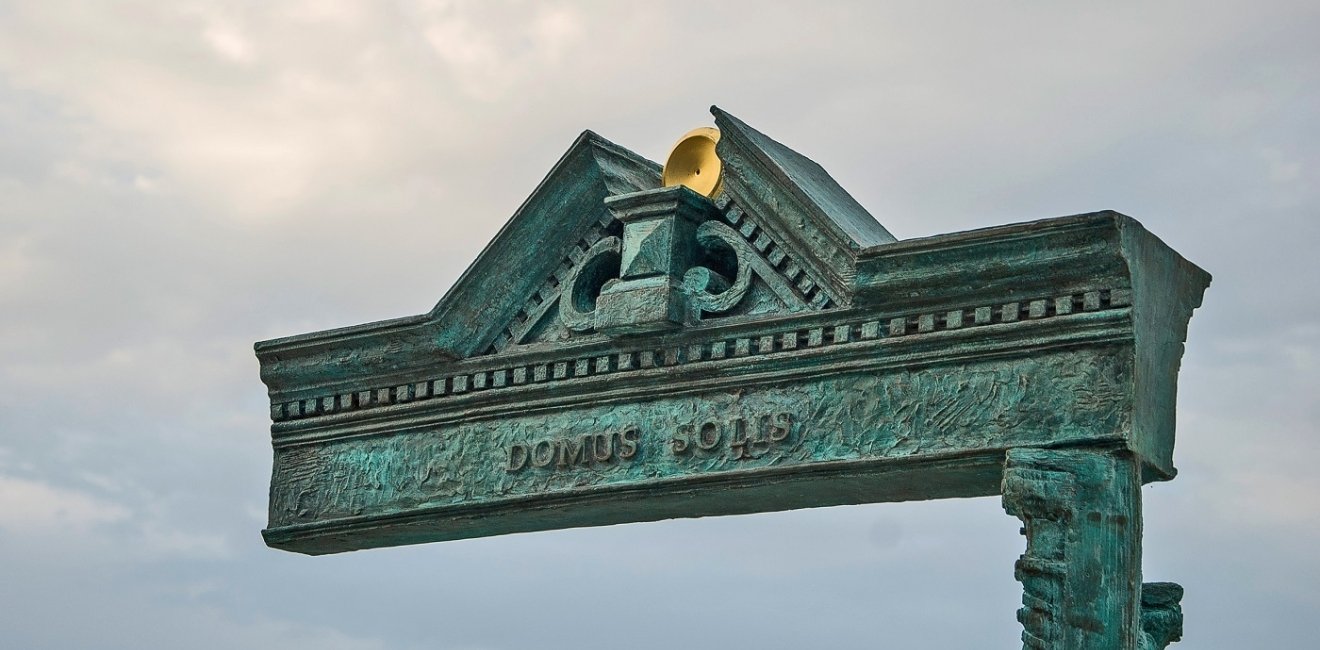
A blog of the Kennan Institute
Acclaimed Odesa sculptor Mikhail Reva cautiously approached his summer home earlier this year at the Black Sea resort of Zakotka, knowing it had sustained damage from a Russian missile that had landed nearby. Fortunately, his sculptures remained unharmed, even though the door to his studio had been blown off. His neighbors had collected shrapnel and fragments from the attack and gave them to Reva. He soon set out creating a 10-piece collection from the wreckage, which he ironically entitled “Russian World.” At its center stands a sculpture of Moloch, an ancient god demanding sacrifice, in the form of a Russian bear more than a dozen feet tall. The collection includes a dragon molded from the roof of a Russian Kamaz truck, and a six-foot owl created with the twirling fins of mortars.
Artist, sculptor, architect, jewelry craftsman, and philanthropist, Reva has built an international reputation for humorous works which elicit smirks as much as broad smiles. Locally, he was known for a series of public sculptures celebrating Odesa’s cynically jovial bravery. These strategically placed tributes include an homage to the famous “twelfth chair” of the 1920s frolicking novel by Ilya Ilf and Yevgeny Petrov, which lampoons early Soviet trickery, as well as a seated figure of local jazzman Leonid Utesov. His half doorway opening to the sea at Lanzheron beach is a favorite spot for touristic selfies.
Reva’s works became so well known that President Kuchma (who held office between 1994 and 2005) commissioned the artist to make a presentation gift for incoming Russian president Vladimir Putin. Reva sculpted a special sundial which long sat on the Russian president’s desk.
The joie de vivre so evident in Reva’s pre-war work and his close ties to Russia evolved over time. The son of a sea captain, Reva moved with his parents from Crimea to Odesa when he was six. He entered high school and the Odesa Higher Engineering School before entering Soviet military service. He continued his studies at Leningrad’s prestigious Mukhina Art and Design Institute, returning to Odesa afterwards. He recalls his Leningrad years fondly as a time of discovery and revelry. Reva won a scholarship from the Academy of Arts to spend a year in Rome. Back in Odesa, he now enjoys local celebrity and considerable artistic accomplishment.
Reva, in other words, was a Ukrainian very much involved in a “Russian world.” No longer. In addition to the Russian missiles falling near his studio, the war brought about the death of his cherished mother, following a difficult evacuation from her ninth-floor Odesa home last summer. Putin’s proclamation of a “Russian World” which includes Ukraine angers Reva as he contemplates the destruction of childhood landmarks in Odesa and the brutality inflicted by Russians elsewhere in Ukraine. The Russian bear has been transformed into the Old Testament demon Moloch.
Reva is arranging to exhibit his “Russian World” sculptural ensemble in London, Berlin, New York, and elsewhere. He is planning for a possible permanent home in Kyiv once the hostilities have come to an end. He now feels shame for his rapturous student days in Leningrad and Russia. As he told The Guardian’s Luke Harding in April, “this is a war of Cain versus Abel, David against Goliath. My small country has resisted a great monster.” His art has a new mission.
Reva is perhaps most proud of his 1996 sculptural project “Angel of Grace,” created for The Future, a children’s rehabilitation center founded by Odesa activist Boris Davidovich Litvak. The work’s inscription expresses Reva’s deeply held belief that humans can shape positive outcomes. It reads: “Do not refuse good deeds when your hand is able to do it.” Those “good deeds” assume new meaning in light of how the Russian invasion has changed Reva’s life, as it has transformed the lives of all Ukrainians. He now embraces telling truths about Russia which he had not appreciated previously. For Reva, as for many of his compatriots, the “Russian World” has become an evil phantasmagoria.
The opinions expressed in this article are those solely of the author and do not reflect the views of the Kennan Institute.
Author

Former Wilson Center Vice President for Programs (2014-2017); Director of the Comparative Urban Studies Program/Urban Sustainability Laboratory (1992-2017); Director of the Kennan Institute for Advanced Russian Studies (1989-2012) and Director of the Program on Global Sustainability and Resilience (2012-2014)

Kennan Institute
After more than 50 years as a vital part of the Wilson Center legacy, the Kennan Institute has become an independent think tank. You can find the current website for the Kennan Institute at kennaninstitute.org. Please look for future announcements about partnership activities between the Wilson Center and the Kennan Institute at Wilson Center Press Room. The Kennan Institute is the premier US center for advanced research on Eurasia and the oldest and largest regional program at the Woodrow Wilson International Center for Scholars. The Kennan Institute is committed to improving American understanding of Russia, Ukraine, Central Asia, the South Caucasus, and the surrounding region through research and exchange. Read more

Explore More in Focus Ukraine
Browse Focus Ukraine
Talking to the Dead to Heal the Living

Ukrainian Issue in Polish Elections


